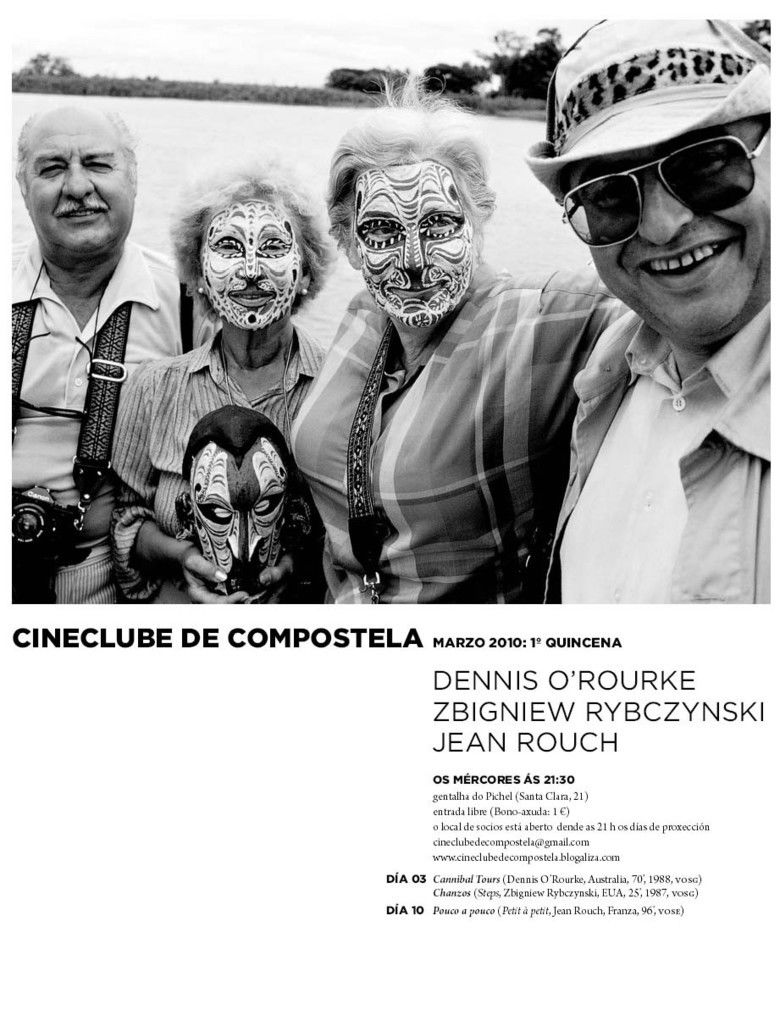Cannibal Tours
7.8 /10 1 Votes7.8
Director Dennis ORourke Genre Documentary Country Australia | 7.8/10 IMDb Cinematography Dennis ORourke Duration Language English | |||||||||||||||||||||||||||||||||
 | ||||||||||||||||||||||||||||||||||
Release date 1988 (1988) Producers Dennis ORourke, Laurence J. Henderson Similar movies First Contact (1982), Black Harvest (1992), Trobriand Cricket (1975), Adjust Your Color: The Truth of Petey Greene (2008), A Diary for Timothy (1945) Tagline There is nothing so strange in a strange land, as the stranger who comes to visit it. | ||||||||||||||||||||||||||||||||||
Cannibal tours 1988 dennis o rourke
Cannibal Tours is a 1988 quasi-documentary film by Australian director and cinematographer Dennis O'Rourke. While it borrows heavily from ethnographic modes of representation, the film is a biting commentary on the nature of modernity. The film is also widely celebrated for its depiction of Western touristic desires and exploitation among a 'tribal' people.
Contents
- Cannibal tours 1988 dennis o rourke
- cannibal tours 1987 clip 3 on aso australia s audio and visual heritage online mp4
- References
The film follows a number of affluent European and American tourists and ecotourists as they travel from village to village along the middle Sepik River in Papua New Guinea. Most of the villages in the film are inhabited by the Iatmul people. The film shows the tourists driving hard bargains for local handcrafts such as woodcarvings and baskets, relentlessly taking photos of local people, handing out cigarettes, balloons, and perfume, viewing staged dance performances, and offering naive comments on native people living in harmony with nature. The film, too, tacks between the tourists and black-and-white photographs from the era of German colonialism of New Guinea (1880s-1914). With some prodding, the tourists unwittingly reveal an unattractive and pervasive ethnocentrism to O'Rourke's cameras. The tourists thus become somewhat dehumanized by the filmmaker's camera even as they themselves dehumanize and exoticize even the most mundane aspects of Sepik River life.
The title of the film can be read in at least a couple of ways. At one point early in the film, a German tourist, clearly titillated, describes the bygone practice of raiding and cannibalism. He is obsessed with cannibalism, asking local men about the former practice, and snapping photos of locations where local people once practiced headhunting; other tourists also attempt to discuss the "symbolic" meaning of cannibalism. But the narrative plot of the film is to portray the tourists as the real cannibals who consume the world through their arrogance, acquisitiveness, primitivist fantasies of indigenous people, and photography (the cameras in the film double for the guns of past colonial administrators). In short, the film presents the tourists as the people driven by truly bizarre beliefs and behaviors. By contrast, the local people are represented as eminently practical and reasonable. Thus the 'natives' display the rationale logic of modernity, while the Western tourists are guilty of the very irrational traits they attribute to the natives. The climax of the film is when a group of tourists, faces painted in 'native fashion' by local men from one village (Tambunum), prance, dance, and assume a boxing stance to the music of Mozart. The message is clearly: we (the tourists) have finally succeeded in our quest for the primitive, and'he' is us.
cannibal tours 1987 clip 3 on aso australia s audio and visual heritage online mp4
References
Cannibal Tours WikipediaCannibal Tours IMDbCannibal Tours themoviedb.org
